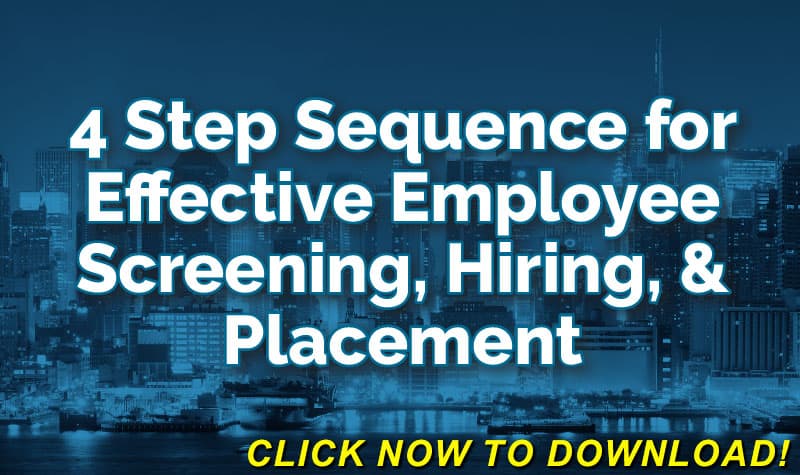Peter Drucker stated, “a company’s most valuable asset is its people.” Any businessperson with nearly any amount of experience can attest to the truth of this statement.
Employers will realize the most success with their employees by ensuring the individuals hired are well positioned for success including the ability to physically complete the essential functions of the job.
This post is one in a 3-part series:
Pre-Employment Policies and Procedures
While employment laws limit the times when an employer can ask an employee about their physical condition, prior injuries, and restrictions on their activity, doing so when appropriate is invaluable. Potential underlying conditions that could result in work injuries can be uncovered and either accommodated or render the person physically unqualified for the position.
There are times employers can conduct various testing to objectively determine if a job candidate is appropriate for the job. Putting in place a policy that addresses various steps in the hiring process will ensure a candidate’s ability to safely perform the necessary tasks.
Click Link to Access Free PDF Download
“4-Step Sequence For Effective Employee Screening, Hiring, & Placement”
- Job task analysis and functional job descriptions. Before the hiring process begins, it’s imperative to understand exactly what the job requires of the employee. These are detailed, objective, measured, and quantified analyses and descriptions that provide the basis for making informed and accurate decisions in hiring.
For example, the job of a truck driver might begin with the requirements necessary to get into the cab of the truck. A detailed job description could include the height of each step to enter the cab, and the angle of the bent knee required. Someone who was not tall enough to reach the first step or had knee problems might be disqualified.
- Pre-offer agility testing. These can be administered to job applicants before the interviewing process even begins. The employer may not ask the candidate about her medical history and may only take heart rate and blood pressure with consent. But companies can ask the candidate to perform actions required of the job, such as lifting and other functional job-specific tasks. The test is the first step to determine if the person can safely perform the job’s simulated essential functions.
- Post-Offer Functional Employment Testing. This is the most important aspect of the hiring process in that it uncovers conditions that could lead to injury, based on the requirements of the job. The employer makes a job offer conditional on this testing.
When done correctly, this testing should investigate all the joints of the body to assess the pre-existing status of arthritis, joint stability, motion and strength, cardiovascular, and neurological status. The tests can also be customized for a particular job. For example:
- Upper Quadrant / Carpal Tunnel testing can be used to determine a candidate’s ability to handle a job with repetitive job functions.
- Vision and hearing screenings may be administered to those seeking positions where these are a factor.
Applicants deemed unable to qualify for the position based on the results of this testing should receive treatment or medical clearance from a physician to continue to the functionality testing.
- Functionality testing. A part of the post-offer testing, the candidate is tested by simulating the weights, forces, distances, and activities of the essential functions of the job.
The value of such testing cannot be overstated. One company reports that one in 14 assessments results in a ‘not capable’ determination. The average savings for each is $38,000.
Additionally, such testing establishes the job applicant’s physical baseline upon starting to work. The information can be used during the investigation of a subsequent work injury to determine the extent of the injury actually caused by the work.
For example, say post-offer testing reveals a pre-existing 20% loss of strength and motion to the right shoulder, but also the person’s ability to lift 70 lbs from the ground, 40 lbs overhead, and other tasks as required to meet the essential function demands. After the same shoulder is injured, suppose there is a 25% loss of shoulder strength and motion. Using the baseline testing results shows the extent of the injury was actually minor and may only require ice, massage, and taping. Had there been no baseline testing for comparison, the employer would assume the injury caused the full 25% strength loss compared to the uninvolved shoulder, and the candidate would likely be taken off work and referred for an MRI and structured physical therapy.
Legal Issues
Employers should take note of pertinent laws like the Americans with Disabilities Act, and applicable state laws when crafting their policies.
It is also important to treat all job applicants with dignity and respect. A history of prior work injuries does not mean someone is unscrupulous, seeking to “game the system,” or will have a work injury the first day on the job.
Nonetheless, legally collecting individualized medical and functional measures is the BEST evidence to match applicants to their specific job demands AND to provide the appropriate intervention if an injury ever does occur.

Contact: mstack@reduceyourworkerscomp.com.
Workers’ Comp Roundup Blog: https://blog.reduceyourworkerscomp.com/
©2020 Amaxx LLC. All rights reserved under International Copyright Law.
Do not use this information without independent verification. All state laws vary. You should consult with your insurance broker, attorney, or qualified professional.












